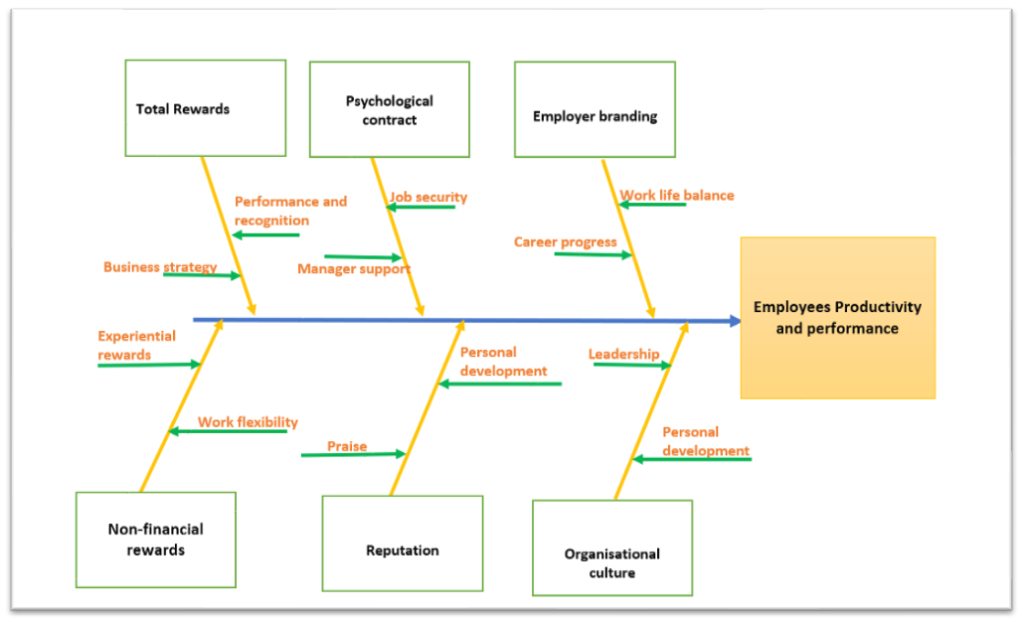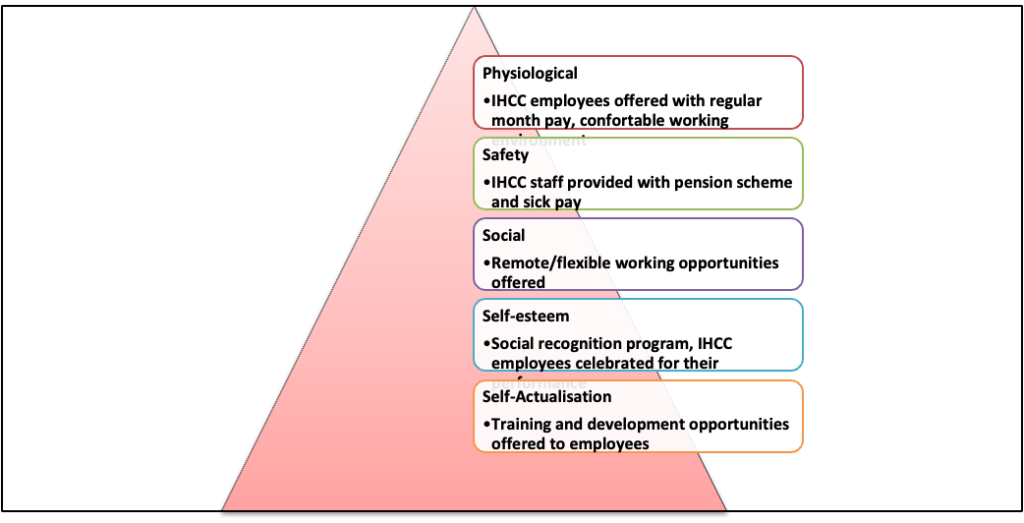2.0 Critical Appraisal of Approach to Reward (1950 Words)
The rationale of understanding the approach to rewards in an organisation is identified by Luque et al. (2020) through a reference on gaol-directed theory as understanding the best practice to attract and retain talents and all stakeholders. This is by ensuring the rewards embrace equality, competitive and appropriate. The outcome of this is employees motivation to extend their input by exercising discretionary behaviours. To affirm this, Wang et al. (2019) report which evaluated rewards behaviours in different sectors and businesses noted that in contemporary labour market, upto 85% of entities are encountering issues with getting, keeping and motivating good talents. The phenomenon is identified by Abdullah et al. (2021) to have been further made complex by prevalence of COVID-19 owing to its implication on reward management.
2.1 IHCC Approach to Pay Structures and Pay Progression in Organisation
2.1.1 IHCC Approach to Pay Structures
In the contemporary highly competitive business environment, there is a need for organisations to have an elaborate pay structure as a reward approach. According to Munasinghe et al. (2021), the rationale of this is to ensure that organisation values are put into account and best approach of an organisation strategy implementation prioritised. Considering IHCC, from the performance-based pay structure and frequent pay progression, highly qualified employees are attracted to the organisation. For the purpose of evidencing the organisation approach to their pay structure, the PESTLE Analysis can be used. As evidenced in CIPD (2021), this tool focusing on political, economic, sociological, technological, legal and environmental is applied for guiding people professionals and senior management in their strategic decision-making (see figure 1).

Figure 1: PESTEL Analysis Components
The IHCC PESTLE analysis informing their pay structure include;
Political- Saudi Arabia (KSA) operate with close political relations with other Middle East countries. It is in this regard that IHCC has ventured into Egypt, United Arab Emirates (UAE) and the Persian Gulf region. Hence, for IHCC, as a basic pay, they offer an average of 79,500SAR annually which is replicated for their employees operating in other Middle East countries. This is with other benefits as part of their total rewards being offered by employees.
Economic- In Alharbi (2021) report, it argued that a negative implication on the pandemic on GDP in 2020 lowered with 9.8%. This had a negative implication on how rewards are offered to the employees. Also, Reuters (2022) report identified KSA economy inflation to have increased to 2.1%. To provide their employees with an opportunity to cope up with this challenge, IHCC has increased all their employees pay with 4.3%. For example, technical services providers annual pay has increased from 79,500SAR to 82,918SAR.
Social- As evidenced in Deloitte (2021) report, 67% of the millennials today occupy senior positions in Saudi Arabia with emerging markets representing 70% as opposed to mature markets 52%. It is in this regard that IHCC has introduced the experiential rewards which are noted to elicit more impact than being offered with cash and tangible incentives. For instance, after every 6 months, IHCC employees are offered with an opportunity of fully paid travel to concerts, events and cultural activities.
Technology- In Trade.GOV (2022) report, the KSA technology market is projected to attain $2.9 billion as at 2025. This is with an annual growth rate of 12.8%. As such, IHCC has introduced development programs and learning sessions for their employees with an intention of increasing their awareness on use of technology and innovation.
Legal- Saudi Arabia operates under the Labour laws (Papayaglobal, 2022). This stipulates on the mandatory deductions (social insurance tax, occupational hazard) and minimum wage which is set at 4,000 SAR Monthly. Hence, for IHCC, it has already surpassed this rate in its monthly pay.
Environment– Corporate Social Responsibility is a significant area of environment prioritised in KSA. Hence, for employees enrolling in CSR, IHCC offers them 15% increased pay in lieu. Also, IHCC being a turnkey solution provider, they have offered their employees with a facility where they can access electric vehicles being their contribution in green policy intending to increase use of renewable energy sources with 50% (Saudi Vision 2030, 2022).
The advantages of the IHCC pay structure is their approach in using job families. As evidenced in Elage and Dardour (2021) this is an approach of grouping jobs with similar occupations/functions together. For instance, in IHCC, there are different families such as Admin, Technical Services and IT (see figure 2);

Figure 2: IHCC Job families
Hence, through the use of job families, the organisation is in a position of identifying roles in the entire business which are at par with each other, capture essential information with compliance with all legislation. Nevertheless, the use of job family is noted to increase bureaucracy while also being limitedly compatible with team-based structure and incentives. There is hence a need for IHCC to improve this structure for an improved effectiveness in their pay structure.
Further, in regard to pay progression, IHCC adopts an automatic time-based phased progress systems. According to Nemțeanu et al. (2022) owing to the prevalence of COVID-19 pandemic, there is a need for changing the pay progression. This is since the current approach has been impacting negatively on the employees motivation and maximum roles performance. Further, adopting a time-based pay progress in IHCC has a negative implication to them as it only evident that performance is only what is core. This is affirmed in figure 3 Fishbone diagram (Ishikawa cause and effect) which has evidenced the current reward progress structure in IHCC as significantly leading to issues of performance and employees turnover.

Figure 3: Fishbone Diagram (Ishikawa Cause and Effect)
As evidenced in figure 3, for IHCC to successfully improve on their rewards progression, they need to invest on areas of psychological contract, reputation, non-financial rewards and integrate their rewards to organisation culture. As it shall be explained later in this report, IHCC rewards is not fully integrated with their strategy and particularly culture. By appropriately embracing an alignment of their rewards and organisation strategy, it would be identified as an employer of choice. It is clear that IHCC pay progression does not work as a magnet for calibrating the employees compasses by being recognised by all as it majorly prioritises on financial rewards. Considering successful organisations such as Saudi Aramco in KSA oil and gas industry, they have been rated the best in terms of communicating on importance of all round pay progress rather than performance-based only. Further, Saudi Aramco provide their employees with equity in terms of pay progress which is a major area of their reward strategies in employees formative phases. According to Acs and Karpman (2020) such an arrangement offers their employees with a chance for improving their performance for their successful roles implementation.
2.2 Total- Rewards Approach Adopted
By focusing on Middle East context where IHCC is based, Alhmoud and Rjoub (2019) identify the total rewards as inclusive of entire monetary, non-monetary, extrinsic, intrinsic and social benefits offered to an employee from their employer organisation. The importance of total rewards are identified in CIPD (2022a) as making sure an organisational commitment and will in remaining among employees is achieved. This is with the increased employees motivation and retention contributing positively to development of top-notch people performance and workforce loyalty. The different components of total rewards are as illustrated in figure 4;

Figure 4: Total Rewards Components
Considering figure 4 components of total rewards, supported by Maslow’s Need Hierarchy Theory (Li et al., 2019), the total rewards ought to form the background of human behaviours and motivation. For the employees motivation and satisfaction, IHCC adopts the use of Maslow Needs Hierarchy Theory to ensure that the total rewards is used in achieving their overall spectrum of satisfaction and motivation (see figure 5);

Figure 5: Link of Total Rewards and Maslow Needs Hierarchy Theory in IHCC
As illustrated in figure 5, through total rewards, IHCC is noted to be in an appropriate position of motivating all their employees. This is supported by Riaz et al. (2018) which note that through total rewards, it is possible to harness the ability to integrate multifarious needs, prioritisation and entity expectations achieved.
Further, the relevance of total rewards in IHCC could also be linked with the Alderfer’s ERG Theory (Bello et al., 2022) noting people who possess different needs which entail existence, relatedness and growth and development. Hence, for IHCC, they ensure they align their rewards with organisation culture, capacity development opportunities and career growth. This has a positive implication for IHCC goals and objectives. For instance, today, they have a fully integrated design system for top firms in KSA. This is while ensuring that they have expanded their operations not only in KSA but in Middle East
2.2.1 Importance of Monetary Components of Total Rewards
Monetary incentives as part of Total Rewards are defined by Lazear (2018) as inclusive of a definitive monetary value liquidated in future or hitting their bank accounts. Monetary rewards are elaborate despite Lavrova et al. (2018) findings as inadequate in performance improvement. As aforementioned, in Maslow Hierarchy of Needs Theory, Money being a symbol of power and status lead to achieving social, security and physiological needs. Considering Herzberg 2-Factor theory O’Bear (2019) noting monetary components as being maintenance factor. This entail piece rate, pay increase, bonuses and profits shared. In the past years, IHCC has been using monetary components with zero rewards customisation.
The outcome of this has been an increase in the turnover to 30%, reduced capacity to attract highly qualified employees and reduced overall engagement. The identified job family rewards structure has been inclusive of increasing pay rise. However, Lorenz et al. (2022) argued that such organisations are inadequately facing risks as most of the rewards are performance-based. This negatively affect scope of creativity in an organisation. Hence, as part of IHCC recommendations, they need to integrate total rewards as part of their operations. This means that they would not only rely on monetary but also non-monetary rewards. This would reduce the overall number of absenteeism and challenges with overtime working.
2.2.2 Importance of Monetary Rewards
Please click the icon below to access this assessment in full
